Going to Nowhere
Ever since I read Jan Morris’ book Trieste and the Meaning of Nowhere 1, I’ve wanted to go there. I read the book twice and was captivated by her descriptions. (I’ve written about the book before – here and here.) Morris called the city the “Capital of Nowhere”. It was a place where artists, writers, soldiers, aristocrats, business barons, and bums all found a place to land.
When we visited Trieste, I was looking for something I’d read about. A feeling. An atmosphere. A vibe.
And at certain moments, I almost found it. But it turns out I was looking something that no longer exists, at least not in the full light of day. My preconceived ideas came from a book that was written 25 years ago, by an author who had visited the city during the preceding 50 years.
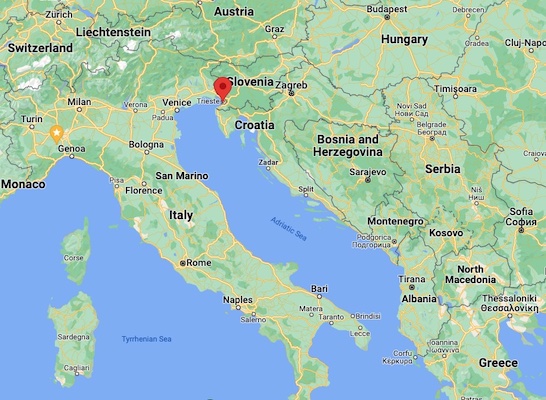
What is this place?
Jan Morris described Trieste as a city that seemd to have lost its purpose. During the 18th and 19th centuries it had been a jewel in the crown of the Austro-Hungarian empire. The Habsburgs transformed Trieste from an old city with moldering Roman ruins at the edge of European civilization into an imperial port that handled cargo from around the world. It was a place where commerce was conducted, ships were built, operas were performed, and fortunes were made.
But in 1919 all that changed. The Habsburg empire collapsed at the end of World War I and for the next 35 years Trieste was handed off several times. Immediately after the war, the surrounding countryside went to Yugoslavia, but Trieste became part of Italy. After World War II, the city was divided and controlled by occupying armies – Brits and Americans in one section, Yugoslavs in another. Then it became a “Free Territory”, overseen by the United Nations. Finally, in 1954, it was handed back to Italy.
During the Cold War in the 1970’s and 1980’s, Trieste became a hub for entrepreneurs buying Western goods to take back through Yugoslavia to other Communist countries, where such goods were in high demand and short supply. But with the fall of the Soviet Union, that trade dried up.
All of that would be enough to rattle any Chamber of Commerce or Economic Development Board.
During her last trip in 2000, Jan Morris wrote that she saw signs the city was developing a new identity. New centers of science and technology were being formed. A nascent tourist industry was developing. She saw hope for the future, but she acknowledged that she would never see it realized, so Trieste was always in her mind as “half-real and half-imagined”. And that was the picture stuck in my head.
The places we saw
We saw many of the places she wrote about.
On our first evening, we walked around the Canal Grande. It was just as I had seen it in photos. And even though it is only 330 meters long, it still qualifies as “grande”.
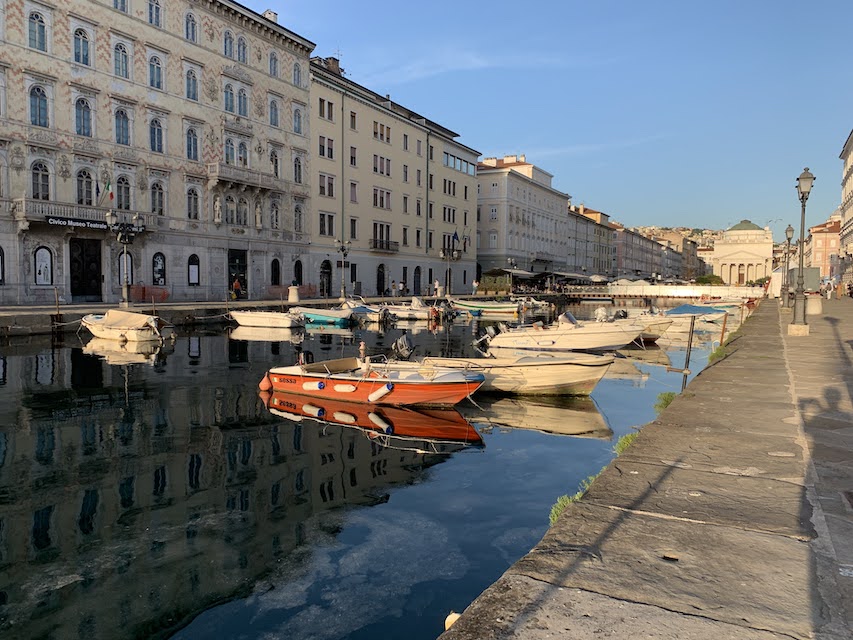
In the Piazza Ponterosso, just off the canal, we saw Giovannini, the little putto in the fountain. He reminded us of the Manneken Pis in Brussels, but without the pis.
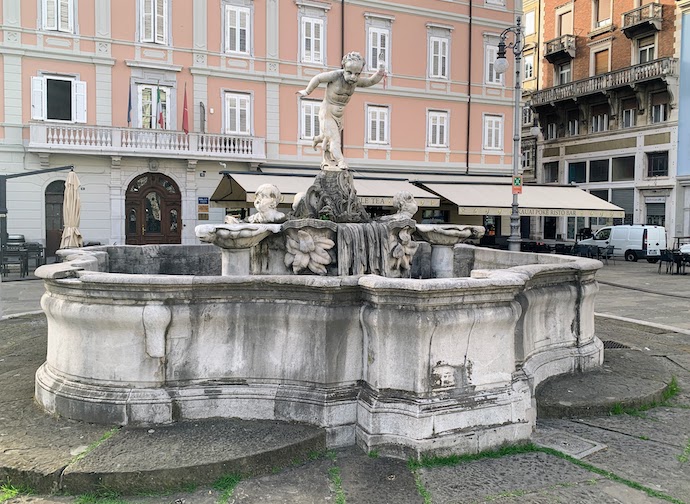
Trieste was most interesting to me in the early morning, while the city was waking up.
The Piazza Unitá was grand and broad and surrounded on three sides by stately buildings that hinted of important things happening inside their walls. The Caffè degli Specchi set out its tables and chairs to await the crowds who would come for coffee or cocktails. It probably looked the same as it did 25, 50, or 100 years ago. The Fountain of the Four Continents occupied a prominent spot at the eastern end of the piazza. And Charles VI surveyed the area from atop his perch.

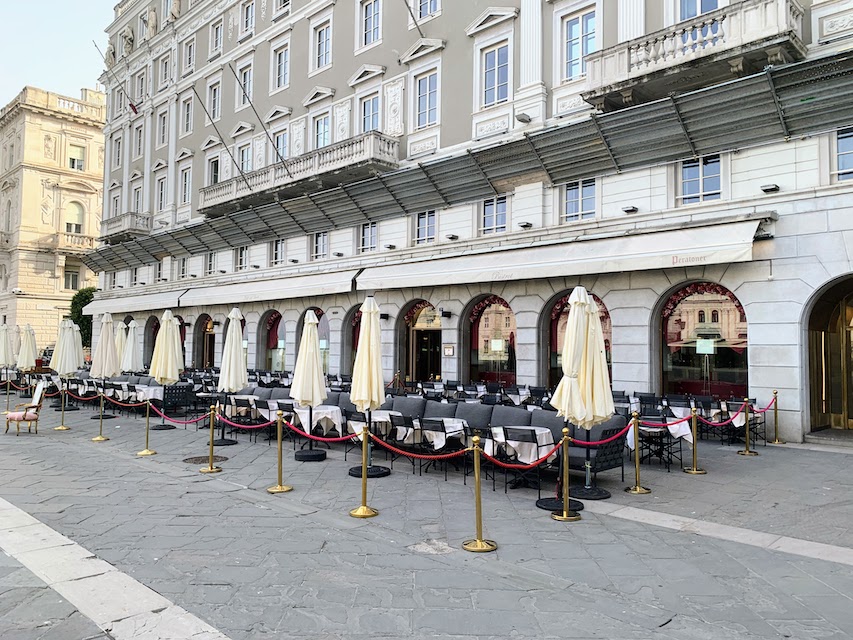
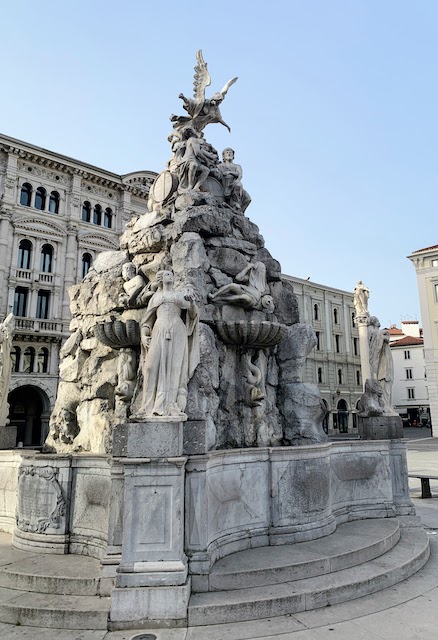
Charles VI is in the background, right
We walked along the harbor, where the optimists were already out with their poles and nets. How can you be a fisherman and not be an optimist? They mostly look unhappy, but I think that’s a façade intended to keep the rest of us from knowing what a good time they’re having, because then we might want to muscle in on the action.
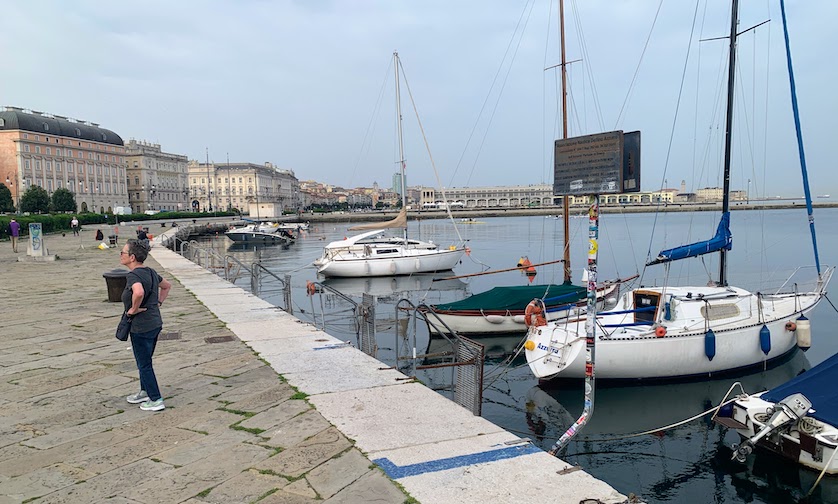
We walked to the end of the Mole Audace, a stone pier built in 1751, with stout bollards to accept the ropes and chains of the ocean liners and military ships that once docked here. Maybe some ships still tie up there, but the bollards were rusty and appeared not to have been used for some time. The freighters waiting to be unloaded were moored out in the bay.
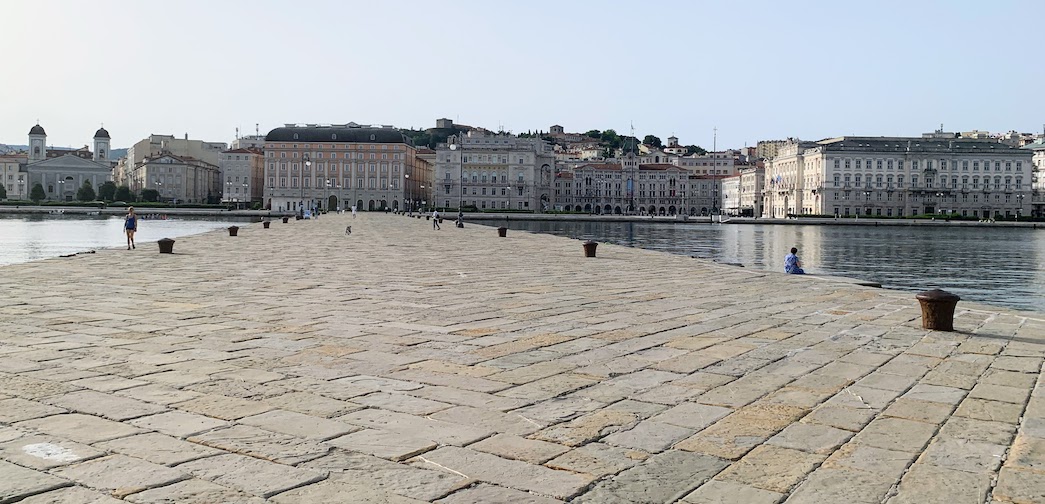
On a gray, cloudy morning, we could barely see the white shape of Miramare castle across the bay. It seemed like the kind of place that belonged in the Capital of Nowhere. Built in the 1850’s by Archduke Ferdinand Maximilian, it was intended to be a pleasure palace for him and his wife Charlotte. But before it was finished, he went on an ill-fated mission to Mexico. He went expecting to be crowned Emperor of Mexico. Instead, the Mexicans captured and shot him. Charlotte had already returned to Trieste, where she slowly went mad.
At the end of the pier, we stopped to look at the wind rose, and looked for the marker at one edge that signified the Bora, the fierce winter wind that blows down from the Karst, the mountain range behind Trieste. The winds are said to be so strong that they have knocked over carriages, horses, and people. No word on whether it blows over girls on Vespas or rocks the local buses.
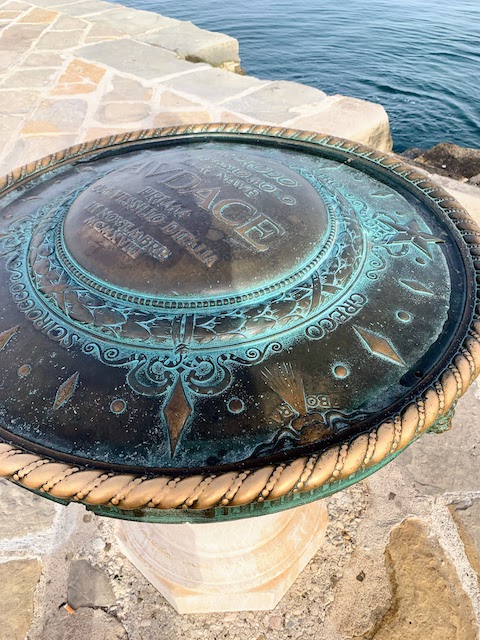
We climbed the hill to the cathedral, San Giusto, up cobblestone streets that are likely unchanged, except for the traffic passing over them, in the last 100 years. The asymmetrical facade of the cathedral was built to join together two existing churches into one larger one and includes stone fragments from earlier, Roman-era buildings on the site. The church and the field of Roman ruins that sits beside it – mostly stumps of columns – are almost certainly the same as they were in the last century and the one before it.
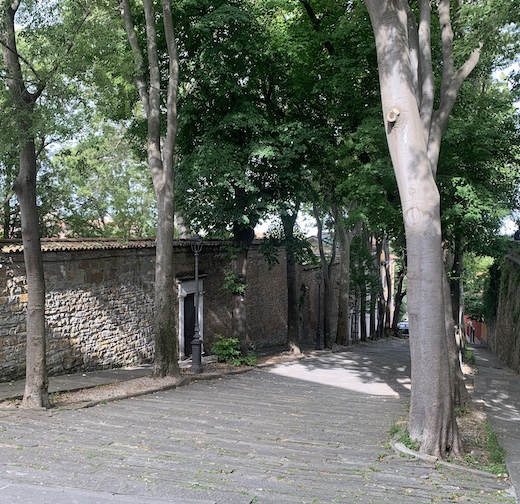
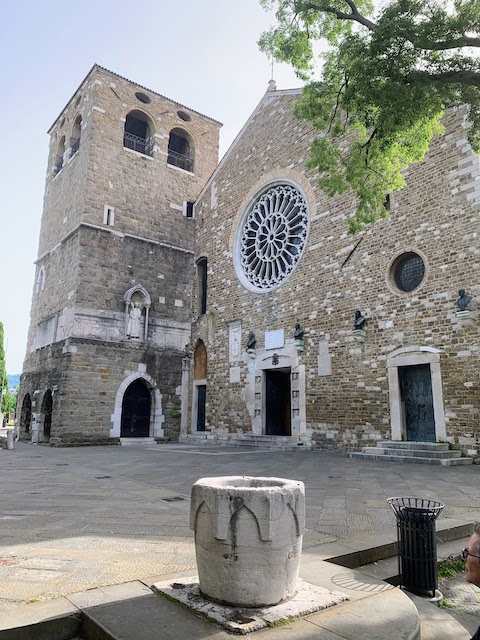

Coming back down the hill, we marveled at the Arco di Riccardo, a stone arch built around 33 BC. It appears to be emerging from, or maybe holding up, a much newer building. While we were admiring the arch, a man walked out on the balcony of an apartment building across the street. I wondered what it must be like to step out of your apartment every day and look down on an antiquity.
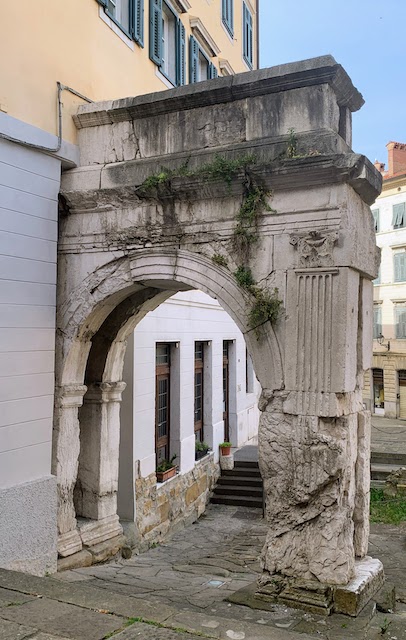
Back down from the cathedral, we come to a small park – the “Hortis Garden”. A placard by its entrance said it had “valuable trees from exotic countries”. It also had a small playground. I hope that kids playing there among the valuable trees can imagine themselves traveling to exotic countries.
The people we met
All along our walks, we stopped to look at statues. Here is one of Maximilian, pointing across the bay towards Miramare. Here is Italo Svevo, the novelist, several blocks away from his better known friend, James Joyce. Joyce spent time in Trieste and wrote Portrait of an Artist as a Young Man and other works in between bar hopping with the locals. Here is the poet, playwright and journalist Gabriele D’Annunzio. And here are “the Girls of Trieste”, forever sewing little Italian flags at the waterfront.
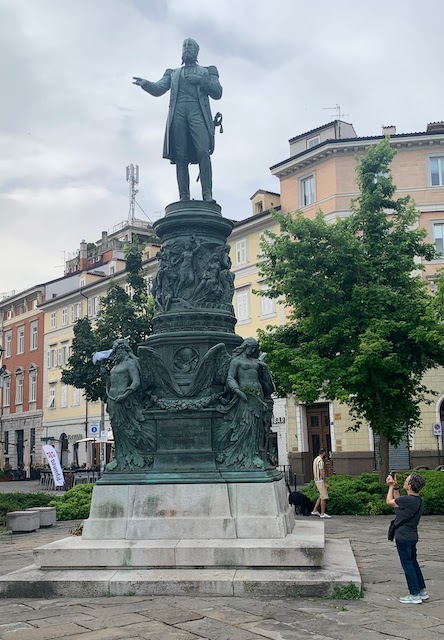
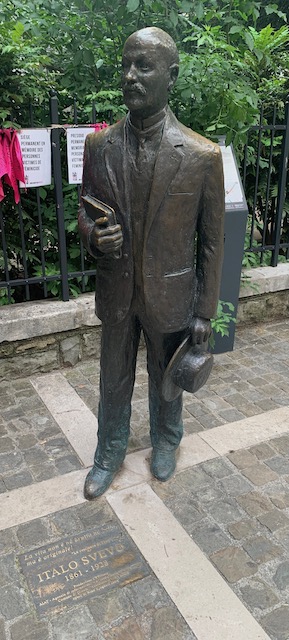
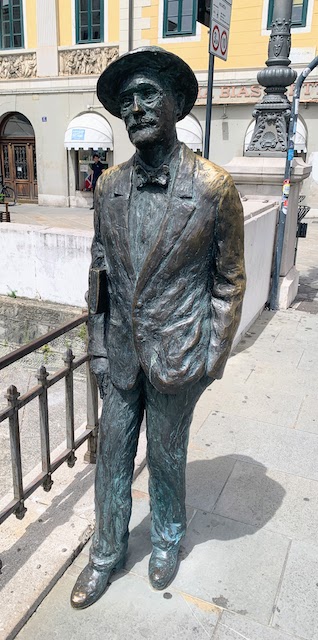
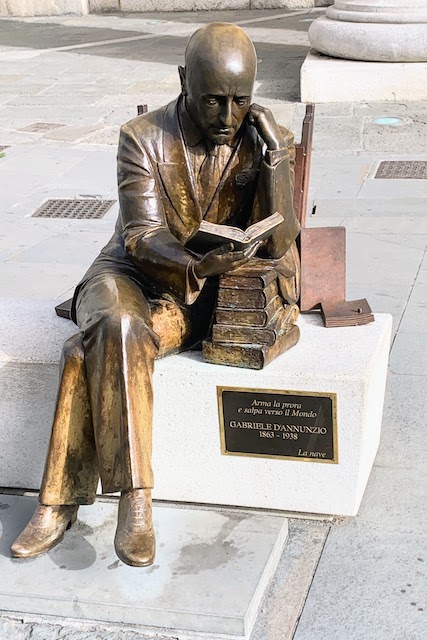
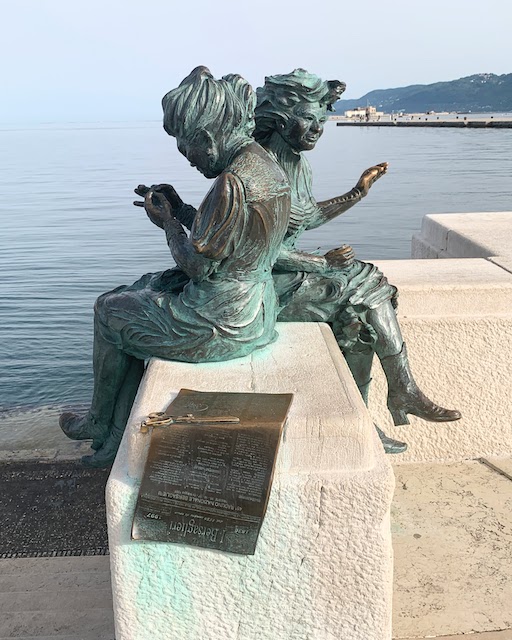
Glimpses of real life
In the Cavana neighborhood, a few blocks south of the Piazza Unitá, a grocer was setting out crates of produce. Just beyond the market, a corner cafe was crowded with neighbors. They were laughing, drinking coffee, smoking, and enjoying the camaraderie of each others’ company. Later in the day they would probably have to deal with the incoming crowds of tourists. But for now, the neighborhood was their own.
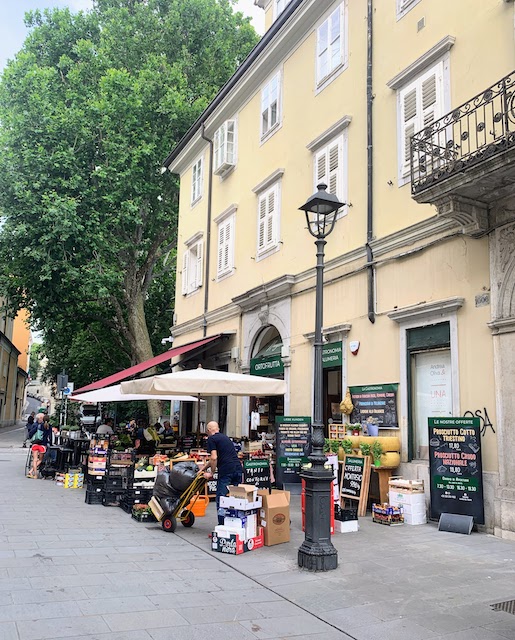
This was real life happening. What was ahead on the street is not. Like so many other places in Europe, the street was lined with stores selling fancy clothes, sunglasses, swimsuits, jewelry, expensive lunches, and Aperol spritzes. All of it provided by, but not intended for, the locals.
Late one afternoon, we had a cocktail at the Caffè Stella Polare, just off the canal. Jan Morris had included it in a list of “classic cafes” in Trieste that dated back into the 1800s. We sat at an outdoor table and watched the tourists go by. Next to us sat an older couple, who looked like they had lived here for years. She was in a dress and pearls. He wore a tweed jacket and tie despite the 90º heat. They enjoyed their drinks quietly. Then just as quietly, they got up and walked away, around the corner and out of sight.
I wondered what they thought about the changes they had seen in their lifetimes.
Is this the future?
Perhaps Trieste has found its missing purpose after all. Maybe its destiny is to be another outpost of the tourist trade.
But maybe the true soul of the city that Jan Morris saw, and that I came looking for, still remains, revealing itself in the early morning, in the empty piazzas, along the waterfront, and at the coffee shops and produce markets, before the crowds of selfie-takers arrive.
“In Trieste” Jan Morris said, “anything might be true.”
Until next time / Até a próxima vez
Mike
The Writer

Where have you gone that turned out different than you expected? Was it better or worse? Tell us your travel story in the comments below or via the Contact Us form.
- This is a direct link to bookshop.org. If you buy a book from them, you can designate that a portion of the sale price be given to an independent bookstore of your choice. Yes, you’ll pay a bit more than buying at Amazon, but the difference benefits independent bookstores, not a billionaire. We do not receive any affiliate payment if you buy a copy. If that changes in the future, we’ll let you know. ↩︎

We found ourselves in Trieste unexpectedly last year. (Cruise ship itinerary change only a few days before). We really enjoyed walking around the city. It was peaceful and almost regal in some parts. Very comfortable in others. Thanks for taking me back!
I love the idea that a town and humans alike can change their purpose, what they are about, what they do, what they are known for…when they need to or even when they have to. Some times this can take centuries or perhaps a day when tragedy strikes.
I love your writing!!!
I wonder, do places lost in time finally fade away, or does their dissonance with a changing world build to breaking and they are snapped, without warning, into the present?
What a beautiful city! I love falling in love with a place in a book and then visiting it!!
Hi Bonnie. Thanks for your comment. It’s funny, one of Jan Morris’s comments was that Trieste didn’t have any outstanding tourist attractions, like Milan or Rome. And that’s true. It’s actually a rather plain place, in a European city kind of way, which was a big part of what captured my interest. I’m glad we went and hope we can return some day.
Have a great week!
Mike
Thank you for taking me along on this pilgrimage. I enjoyed it immensely.
Thanks for coming along, Gay!
What an insightful account of your time in Trieste and its shifting identity. Touring can be so wonderful for us but especially so when we maintain that awareness of our impact and, as you two do so well, make the effort to feel what really living in a place would feel like and how our presence changes those lives. Muito obrigado!
David Hassler
Thanks, David. Trieste is a place I’d like to visit again, for a longer stay. Maybe in the winter. I think it would be a good place to hole up and write a book.
Mike